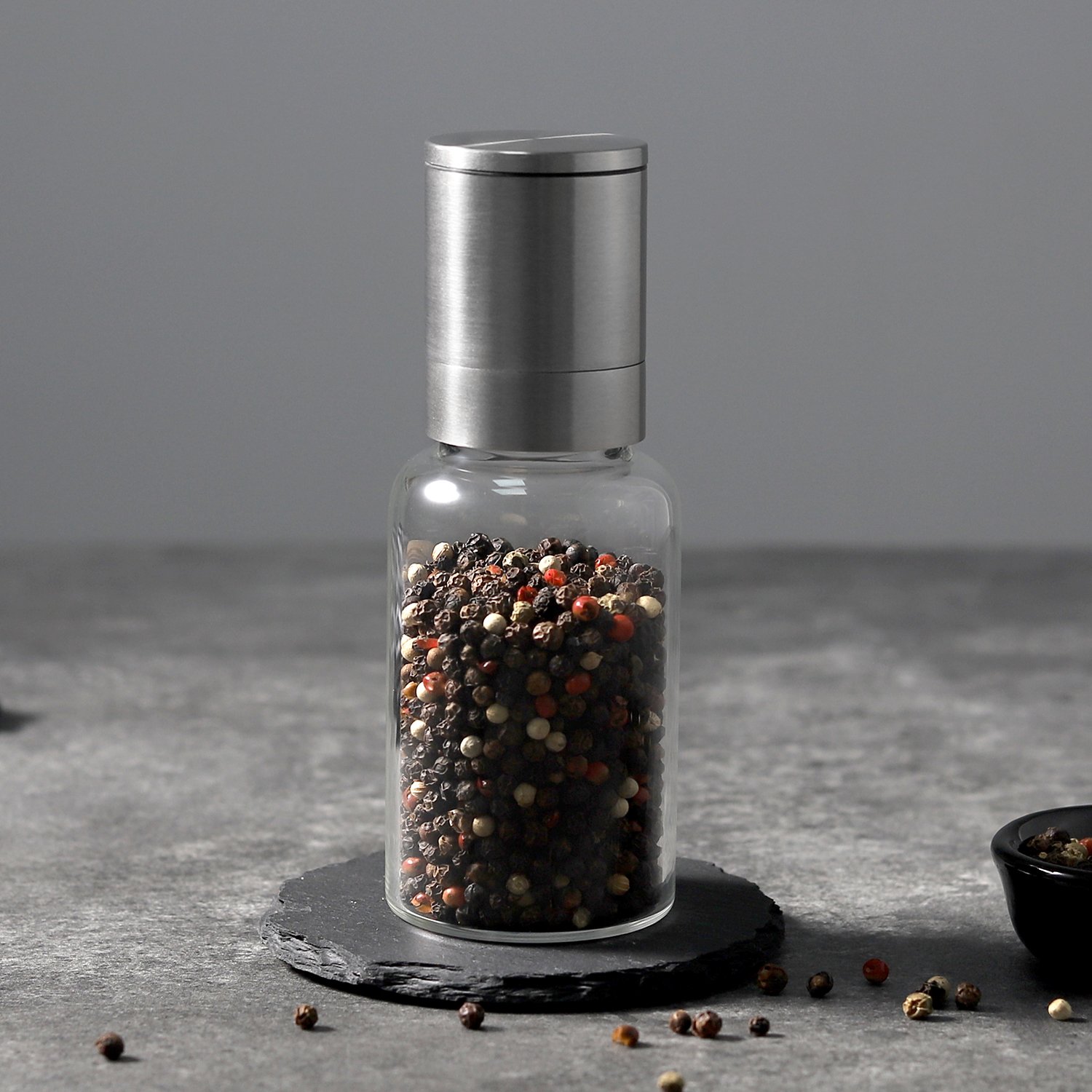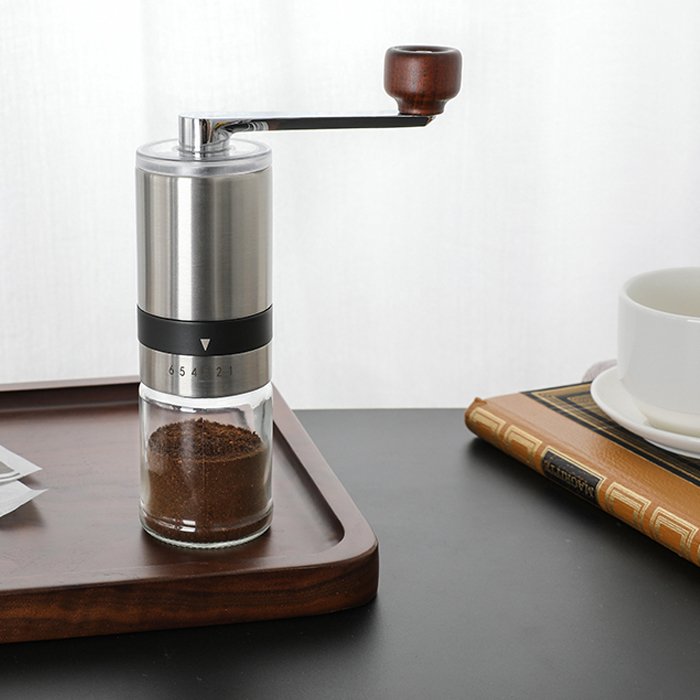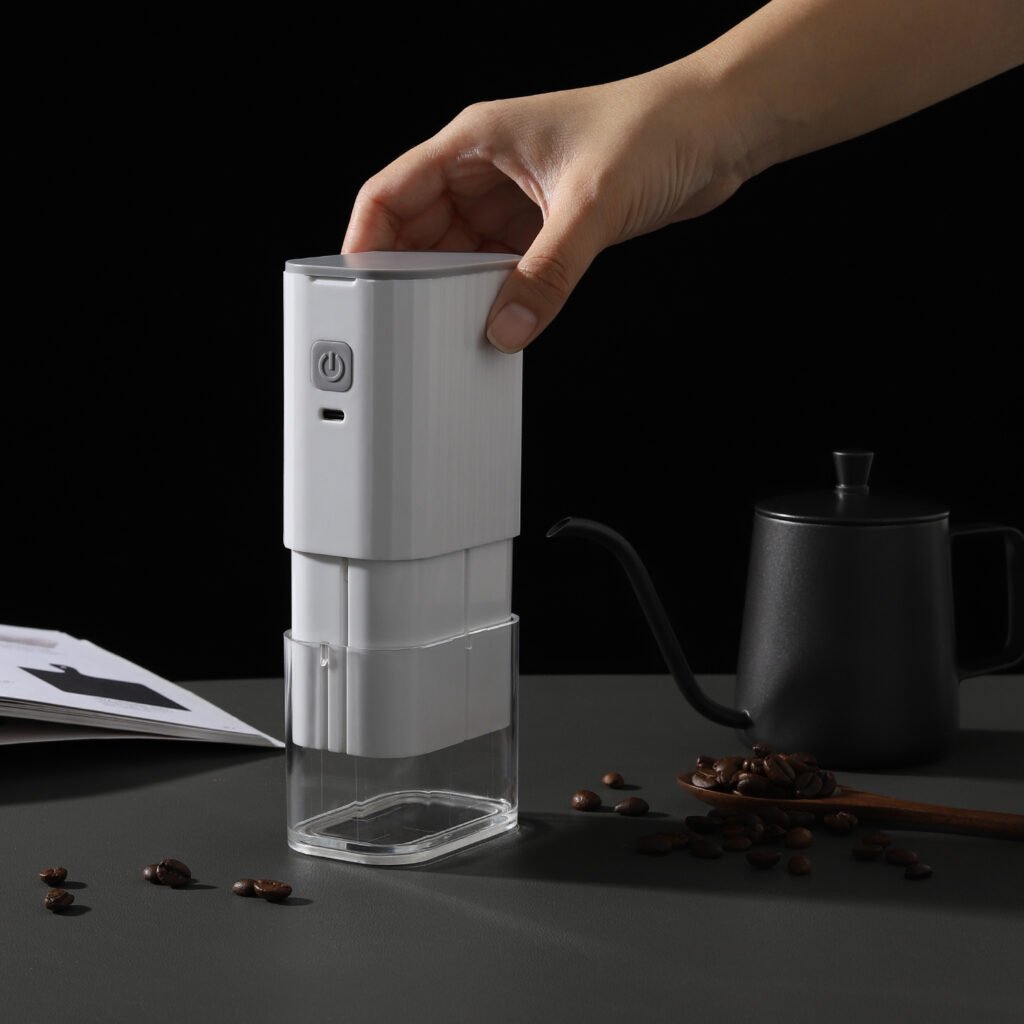
You deserve the freshest coffee every day. By regularly maintaining your hand held electric coffee grinder—whether it’s the best rechargeable coffee grinder or a best compact burr coffee grinder—you’ll enjoy richer flavor and a grinder that lasts longer.
- Regular cleaning keeps performance strong and prevents coffee oils from building up.
- Specialized cleaning products reduce repairs and help every cup taste great.
Daily Maintenance for Your Hand Held Electric Coffee Grinder
Taking care of your hand held electric coffee grinder every day sets you up for coffee success. You build a habit that keeps your machine running smoothly and your coffee tasting fresh. Here’s how you can make daily maintenance easy and rewarding.
Quick Cleaning After Each Use
Start your day by checking your grinder for leftover grounds or beans. Before you grind, inspect the hopper for old beans and make sure the power connection feels secure. After each use, brush out the burrs and grinding chamber. This simple step helps you clean a coffee grinder quickly and prevents stale flavors from mixing into your next cup.
Tip: Keep a small brush nearby. You will find it handy for reaching tight spots and keeping your grinder spotless.
Emptying Coffee Grounds Completely
Never leave old grounds in your grinder. After you finish grinding, empty the hopper and grind chamber right away. Old grounds can attract moisture and cause clumping. You want every cup to taste as fresh as possible. Cleaning a coffee grinder after each use ensures you always start with a clean slate.
Wiping the Exterior
A clean exterior makes your grinder look great and keeps your kitchen tidy. Wipe down the outside, control panel, and buttons with a soft, damp cloth. Pay attention to the chute and doser area. You will notice fewer spills and less mess.
Consistent care helps you spot any signs of wear early, so you can address them before they become problems.
Daily attention to these steps will help you clean a coffee grinder with confidence. You will enjoy better coffee and a longer-lasting machine.
How to Clean a Coffee Grinder: Deep Cleaning Routine
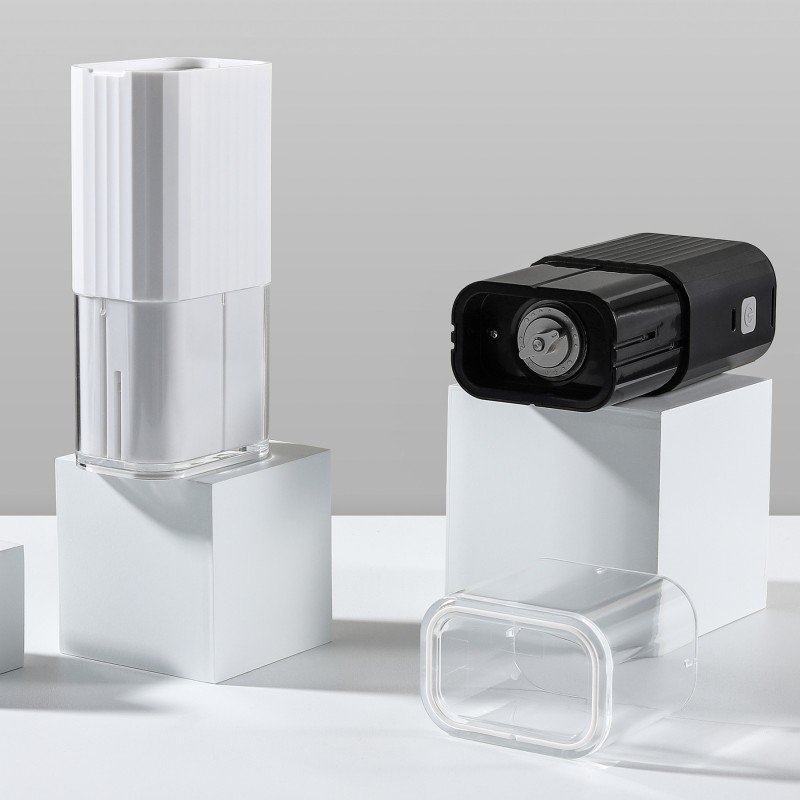
Deep cleaning your hand held electric coffee grinder brings out the best in every cup. You give your machine a fresh start and protect the flavor of your coffee. When you learn how to clean a coffee grinder properly, you set yourself up for success as a home barista.
How Often to Deep Clean
You might wonder how often to clean coffee grinders for the best results. Experts recommend deep cleaning your hand held electric coffee grinder at least once a year. If you use oily beans or grind large amounts of coffee, you may need to clean a coffee grinder more frequently. Regular deep cleaning prevents buildup and keeps your grinder running smoothly.
Tip: If you notice your coffee tastes dull or your grinder sounds different, it may be time for a deep clean.
Step-by-Step Disassembly
You can master how to clean a coffee grinder by following a careful disassembly process. Taking your grinder apart step by step helps you avoid mistakes and keeps every part safe.
- Unplug your electric burr grinder and remove any leftover beans.
- Disassemble the grinder’s removable parts, such as the hopper and burrs.
- Hand wash the hopper with hot, soapy water. Rinse with hot water and dry with a lint-free or microfiber cloth.
- Use a brush to clean the burrs and wipe away any remaining residue with a cloth.
- Clean the coffee grinder’s exterior with a damp cloth.
You should never use sharp objects to clean a coffee grinder. Soft brushes work best and protect your machine. Avoid excessive disassembly, as this can make reassembly difficult and may damage your grinder. Always check your grinder’s manual before you disassemble anything.
Cleaning Burrs or Blades
When you clean a coffee grinder, focus on the burrs or blades. These parts collect oils and fine particles that affect taste. You can brush out loose grounds after each use. For a deeper clean, use mild soap and water on removable parts every week or two. Grinder cleaning tablets work well once a month to remove stubborn oils and residue. If you want to clean a coffee grinder with rice, use this method only for blade grinders, as rice can damage burrs.
Note: Never soak the entire grinder or use harsh chemicals. A dedicated coffee grinder cleaner keeps your machine safe and your coffee tasting great.
Safe Reassembly
After cleaning, you need to reassemble your grinder with care. Make sure every part fits together easily. If something feels forced or misaligned, stop and check the instructions. Improper assembly can cause burrs or blades to become loose, which may lead to dangerous situations. You protect your grinder and yourself by taking your time.
- Double-check that all parts are dry before reassembly.
- Align each component according to the manufacturer’s guide.
- Test the grinder with a small amount of beans to ensure smooth operation.
A well-assembled grinder rewards you with consistent performance and delicious coffee every time.
| Grinder Type | Cleaning Frequency | Additional Notes |
|---|---|---|
| Blade Grinder | Weekly cleaning using rice or specialized cleaner. | Brush after each use; do not submerge in water. |
| Flat Burr Grinder | Daily brushing, weekly upper burr removal, monthly tablets, quarterly calibration. | Common in commercial settings. |
| Conical Burr Grinder | Daily brush-out, weekly thorough brushing. | Easier access for cleaning compared to flat burrs. |
You now know how to clean a coffee grinder and keep it in top shape. Avoid common mistakes like using too much soap, over-disassembling, or using sharp tools. With the right routine, you enjoy better coffee and a grinder that lasts for years.
Preventing Common Issues with a Hand Held Electric Coffee Grinder
You want your coffee ritual to feel effortless and rewarding every day. By staying ahead of common issues, you keep your hand held electric coffee grinder running smoothly and your coffee tasting amazing. Let’s explore how you can prevent the most frequent problems and enjoy a flawless brewing experience.
Avoiding Moisture Exposure
Moisture can change how your grinder works. If water gets inside, it may affect the way coffee grounds move and even alter the grinding process. Take a look at how moisture impacts your grinder:
| Effect of Moisture on Grinder Performance | Description |
|---|---|
| Reduces Static Charge | Moisture lowers static, so grounds stick less. |
| Affects Retention of Coffee Grounds | Less static means fewer grounds left behind. |
| Changes Surface Composition | Moisture can change how coffee particles grind. |
Keep your grinder dry. Store it away from sinks and always dry your hands before use. This simple habit protects your machine and your coffee’s flavor.
Preventing Static Build-Up
Static can make coffee grounds fly everywhere, creating a mess and wasting precious coffee. You can reduce static with easy techniques. The Ross Droplet Technique (RDT) works well at home. Just spray a tiny mist of water on your beans before grinding. This increases conductivity and keeps grounds from sticking.
| Method | Description | Advantages |
|---|---|---|
| Ross Droplet Technique | Light mist of water on beans before grinding | Simple, effective, low-cost |
| Grounded Discharge Plates | Plates that discharge static as grounds pass | Great for commercial grinders |
| Ionizers | Neutralize static with positive and negative ions | Consistent, clean environments |
| Conductive Burr Coatings | Special coatings help dissipate static | Improves grind uniformity |
Try the RDT at home for a cleaner, more enjoyable coffee routine.
Using the Right Coffee Beans
Choose beans that match your grinder’s capabilities. Oily or flavored beans can leave residue and clog the burrs. Stick to fresh, dry beans for the best results. You will notice a smoother grind and a richer taste in every cup.
Not Overfilling the Grinder
Overfilling can cause uneven grinding and make your grinder work harder than it should. To avoid this:
- Fill the hopper only to the recommended level.
- Grind in small batches for the freshest flavor.
- Listen for any unusual sounds that might signal a jam.
You protect your grinder and ensure every cup is as delicious as the last.
| Issue | Description |
|---|---|
| Mechanical Faults | Parts like motors, handles, and switches can wear out or break over time. |
| Electrical Faults | Circuits can short, wires can break, and electronics can fail, causing the grinder not to operate. |
| Jammed Grinders | Grinders can jam due to foreign materials or clogging, preventing the burrs from spinning. |
| Overheated Grinders | Overuse or running without beans can cause overheating, triggering a thermal cutoff switch. |
| Blunt Grinding Burrs | Worn burrs lead to inconsistent grind sizes and require replacement. |
| Misaligned Grinder Burrs | Misalignment can cause variability in grind size, affecting extraction consistency. |
Stay proactive and you will enjoy years of reliable service from your hand held electric coffee grinder.
Troubleshooting and Care for Your Coffee Grinder
Recognizing Signs of Wear
Your hand held electric coffee grinder works hard every day. Over time, you may notice changes that signal it needs attention. Stay alert to these common signs of wear:
- The burr edges feel dull when you touch them.
- You keep having to grind finer to get the same results.
- The grounds become increasingly inconsistent in size.
- Grounds start coming out in clumps instead of loose and fluffy.
When you spot these issues, you know it’s time to clean a coffee grinder or consider replacing parts. Regular care helps you catch problems early and keeps your coffee tasting fresh.
Dealing with Jams or Blockages
Jams can happen, but you have the power to fix them quickly. If your grinder stops or struggles, try these steps:
- Check for clogged coffee grounds in the dispensing chute. Use a small brush to dislodge them.
- Adjust the burr settings to make the grind size coarser if the burrs are too close together.
- Empty the hopper and grinding chamber. Clean the grinding chamber to remove any debris or coffee oils.
A coffee grinder cleaner can help you remove stubborn oils and keep your machine running smoothly. You restore your grinder’s performance and enjoy a hassle-free brewing experience.
When to Replace Parts
Replacing parts at the right time keeps your grinder working like new. Use this table to guide your maintenance routine:
| Part Type | Replacement Frequency |
|---|---|
| Grinding Stones | Every 6-12 months |
| Other Parts (hoppers, buttons) | As needed if worn or damaged |
You extend your grinder’s life when you clean a coffee grinder regularly and replace worn parts. Every step you take brings you closer to the perfect cup.
Proper Storage for a Hand Held Electric Coffee Grinder
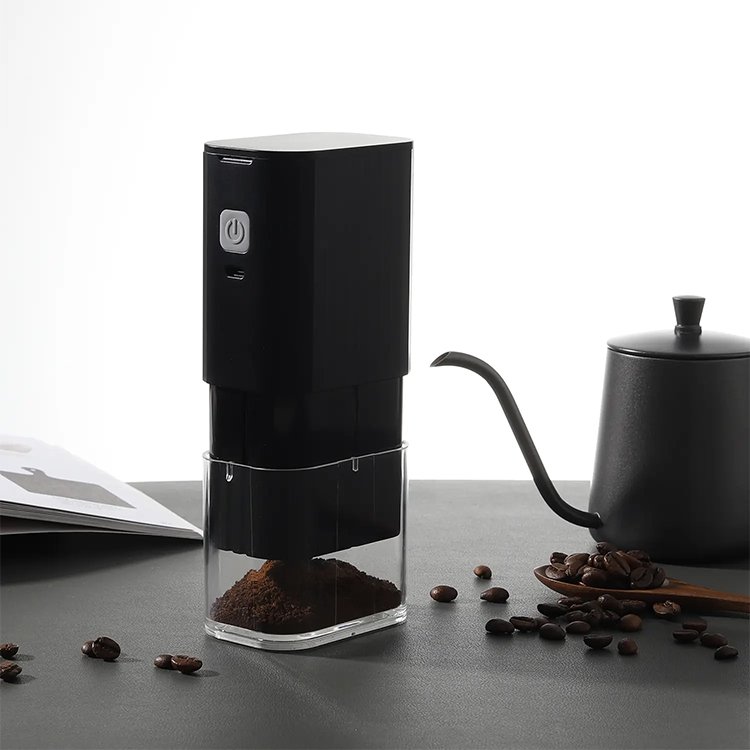
Choosing the Right Storage Spot
You want your coffee grinder to last and perform at its best. The right storage spot makes a big difference.
- Place your grinder in a cool, dry area.
- Keep it away from direct sunlight and heat sources.
- Avoid spots with moisture or temperature changes.
Proper storage helps you protect your investment. When you store your grinder in a stable environment, you prevent damage and keep every cup tasting fresh.
Tip: Never leave coffee beans in the hopper for long periods. Oxygen and light can make your beans stale and affect the flavor of your brew.
Protecting from Dust and Damage
Dust and physical damage can shorten your grinder’s life. You can take simple steps to shield your machine and keep it looking new.
- Clean the grinder and the area around it often.
- Wipe surfaces with a soft cloth to remove coffee dust.
- Avoid using compressed air, which can spread particles instead of removing them.
- Store your grinder in a cabinet or cover it with a clean cloth when not in use.
A clean environment keeps your grinder running smoothly. Regular care prevents oil buildup and stale grounds, which can clog parts and change the taste of your coffee.
You have the power to create a space where your grinder stays safe, clean, and ready for your next coffee adventure. Every small effort adds up to a longer-lasting, better-performing machine.
You hold the power to elevate every cup by caring for your hand held electric coffee grinder. When you clean and maintain it, you ensure consistent grind size, balanced flavors, and lasting performance. Make these habits part of your daily ritual and enjoy delicious coffee with every brew.
FAQ
How often should you clean your hand held electric coffee grinder?
You should clean your grinder after every use. Deep clean it once a month. This habit keeps your coffee tasting fresh and your machine running strong.
Can you grind spices in your coffee grinder?
You can, but coffee and spices have strong flavors. Use separate grinders for each. This way, you keep your coffee pure and your spices bold.
What should you do if your grinder stops working?
Check the power source first. Clean out any blockages. If it still does not work, contact customer support for help. Stay positive—solutions are always within reach!


